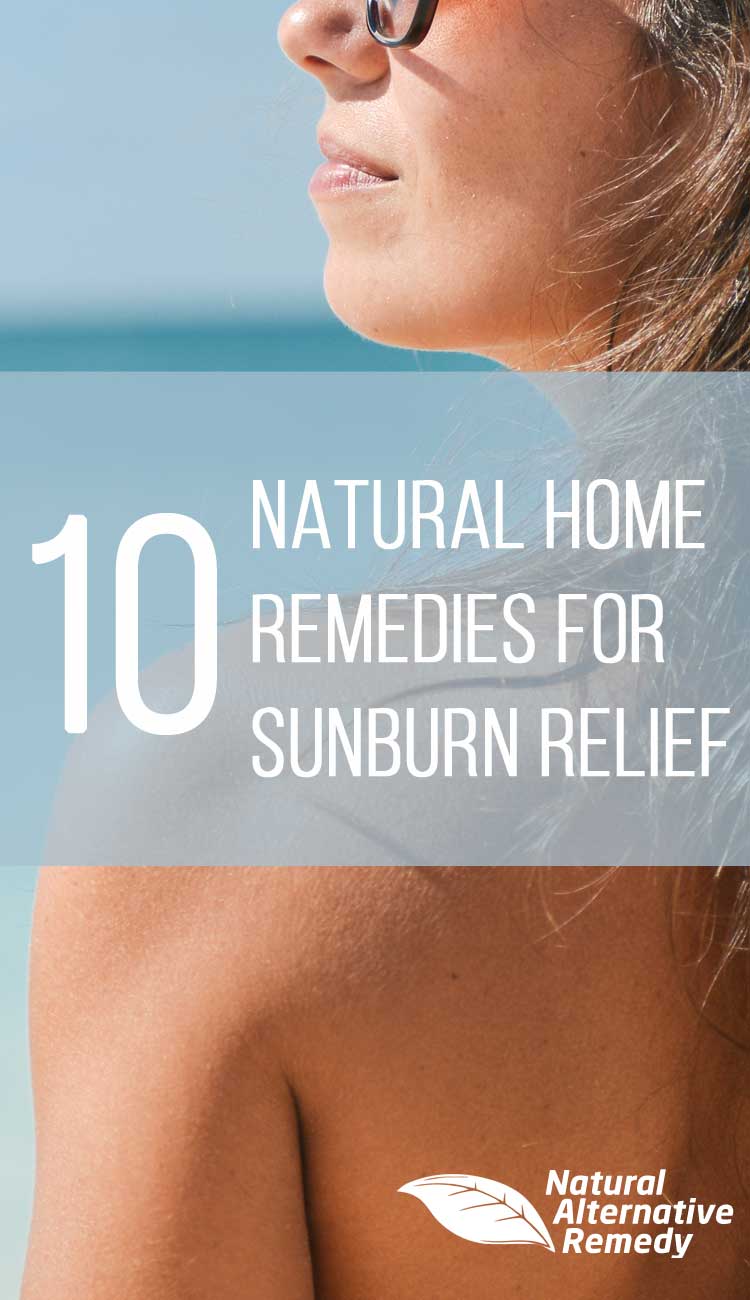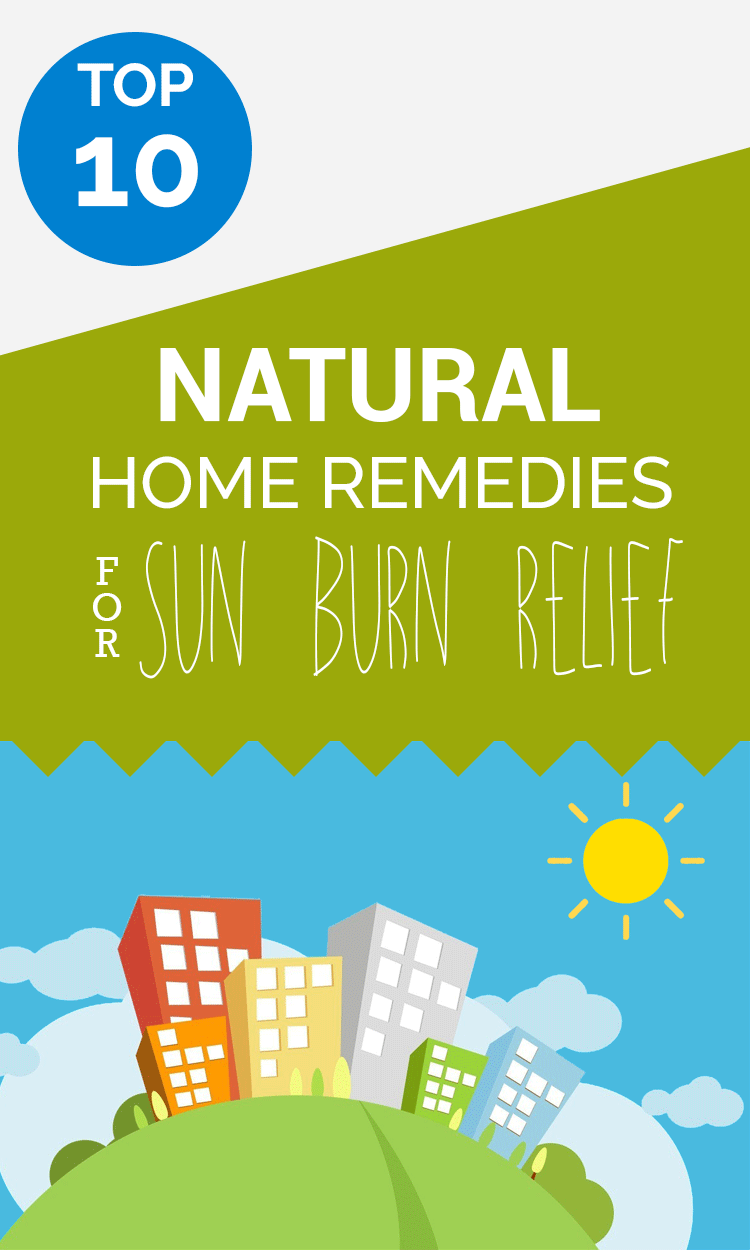
No matter how careful we are, sunburns are bound to happen. While the immediate symptoms of sunburn can be irritating and painful, it’s the lasting effects that are the most worrisome. Not only do sunburns result in skin inflammation and irritation, but they can lead to the permanent sun damage that is at the root of fine lines, wrinkles, sun spots, and most importantly, skin cancer. But you already know the drill. Before going outside, slap on a hat, slather on that broad spectrum SPF, and stay in the shade. We’re not here to revise a winning preventative combination or advise you to run from the sun (in fact, sun exposure is actually good for you!1). We’re here for when you slip up and end up with a red hot sunburn that needs a little natural TLC. Here are 10 great home remedies for sunburn relief you can turn to in your times of skin trouble.
10 Home Remedies for Sunburn
1. Aloe Vera
There is no surprise here. Aloe vera has become the go-to for all things hot, red, and irritated when it comes to your skin. We’re all too familiar with the bright green bottles of gel at the local drug store, but what most of us are missing out on are the healing benefits of pure aloe vera. While scientific evidence of the plant’s therapeutic effectiveness for certain skin ailments is limited and contradictory,2 it has been used in traditional medicines for centuries. To soothe a burn, simply slit the leaf open with a knife and scrape or squeeze out the gooey insides to apply in a thin layer to the sunburned skin. It might be a bit sticky at first, but it will be well worth it.
Don’t have an aloe vera plant to call your own? You should consider it. It is a succulent with thick, fleshy green leaves that is surprisingly easy to care for and great to have on hand as part of a natural home remedy first aid kit. But if you have the opposite of a green thumb, you can purchase fresh aloe vera leaves in the produce section at many health food stores like Whole Foods. For those times when the convenience of a store-bought product is necessary, try to find one without the additives in most brands (like artificial dyes and fragrances) like Seven Minerals aloe vera gel.
2. Oatmeal
Oatmeal is known to naturally reduce inflammation and soothe the skin, making it a great home remedy for sunburn relief. It is also a natural ingredient with very low skin irritant and allergic reaction potential for even the most sensitive of skin types.3 What you’re looking for are the polysaccharides that naturally occur in oatmeal to coat and heal your skin, so you have several options when it comes to treating your burn with oatmeal.
Oatmeal Bath
If you take solace in your bathtub, then you might enjoy soaking in an oatmeal bath. Just stuff an old stocking or tightly tied cheesecloth with whole, uncooked oats and place it under the faucet as you run cool water into the tub. The water will get a bit cloudy, which means that the healing benefits of the oatmeal are infusing into the water. Soak in your oatmeal bath for 15-20 minutes and then air dry.
Though your skin may feel a little slick as it dries, not only will you avoid irritating your burn with scratchy towels, but you will keep some of the healing agents on your skin to continue their work. While the bath might be relaxing, don’t linger for too long. A soak longer than 20 minutes can dry out your skin and cause more irritation, which is not what the doctor ordered. This goes for the following soaking treatments as well.
Oatmeal Mask
We love using an oatmeal mask to soothe irritated skin. We generally recommend using colloidal oatmeal for topical treatments as it has been shown to be the most effective.4 Aveeno makes single use packets of 100% colloidal oatmeal, but you can also find it in bulk here. If you already have some long-cooking, whole oats on hand, you can use a clean coffee grinder or food processor to grind them into a fine powder. Once you have the power, simply add water to make an oatmeal paste that you can apply to the burn. Leave it on for 10-15 minutes before rinsing away with lukewarm water.
Try adding a little pure honey for a thicker texture and added healing benefits! We like Y.S. Organic Bee Farms raw organic honey over any of the more processed options. Or better yet, swing by a farmer’s market for some local raw honey.
3. Baking Soda
Like oatmeal, baking soda helps soothe inflammation (along with a laundry list of other awesome household uses including as a natural air freshener). It’s a natural ingredient every household should have on hand. Also like oatmeal, you can soothe your skin with a soak or topical paste. It is, however, important to note that some people report skin sensitivities to baking soda, in which case we recommend opting for the above colloidal oatmeal treatments.
Baking Soda Bath
For a quick, soothing soak in the tub, toss a handful of baking soda into a cool bath, mix, and soak for 20 minutes. Rinse and gently pat dry.
Baking Soda Mask
Or you can simply add water to the baking soda to form a paste, which can then be gently applied to the burn. You can leave the paste for up to 15 minutes or until the discomfort has subsided. Then rinse off completely and pat the area dry. If you don’t have baking soda on hand, you can substitute this topical treatment with cornstarch.
4. Vinegar
Vinegar naturally contains acetic acid, which is said to relieve pain, itching, and inflammation – three of the most common and irritating symptoms of a sunburn. While plain white vinegar will work (and some prefer it), many swear by the healing powers of unfiltered apple cider vinegar (ACV). Since we prefer ACV for a host of other natural remedies, we always have some on hand.
You can find unfiltered apple cider vinegar in most health food and grocery stores. One of the best selling brands is Bragg’s, but we also like Trader Joe’s private label which is especially affordable when purchased in store.
Vinegar Compress
To use, simply soak a soft, clean cloth with the vinegar and apply it like a cool compress to the painful areas of the burn. You can leave the vinegar soaked cloth on the burn until it dries. Just be especially careful around sensitive areas like the eyes, which can sting or burn if they come into contact with the vinegar.
While unopened bottles of apple cider vinegar can be stored in the pantry at room temperature, we keep our open bottles in the refrigerator, which is especially cooling for this sunburn relief remedy. Just leave the soaked cloth out at room temperature to warm a bit before applying.
Vinegar Bath
For you bath lovers, you can also add one cup of vinegar to cool bathwater and soak for 20 minutes for suburn relief.
5. Milk
Milk straight from the refrigerator can be too cold for sensitive, sunburned skin and for those households who are dairy-free, a gallon of the white stuff isn’t always on hand. So we like to keep a can of evaporated milk on hand. It’s inexpensive, keeps in the pantry, and is still cooling enough for hot, irritated skin. You can simply pour some on a soft, clean cloth and apply to the sunburn, which will provide a protein layer that will soothe the discomfort. If you do choose to go for the good old milk jug, just leave a small portion out on the counter to warm up slightly before using.
6. Cucumber
Cucumber can provide instant relief to sunburned skin, and its analgesic and antioxidant qualities further support healing. While simple sliced cucumber can provide relief when applied to the skin (cucumber eye covers, anyone?), we prefer taking a couple of chilled cucumbers from the fridge to the blender or food processor to create a watery pulp. For a slightly thicker texture and added healthy skin benefits, you can add some pure aloe vera gel, honey, or even cornstarch to the pulp before applying.
7. Witch Hazel
Witch hazel is a staple in most natural home remedy kits. The leaves, bark, and twigs of the plant are used medicinally for a number of ailments. Witch hazel contains naturally occurring chemical components called tannins, which when applied to the skin can reduce swelling, heal broken skin, and even fight infection-causing bacteria. While you can certainly get back to the basics with these parts of the plant, we find that its distilled liquid extract (also known as witch hazel water or hamamelis water) is the most handy. It’s also readily available.
We especially like the Homestead Company’s product, which contains no alcohol and the lowest percentage of benzoic acid (a preservative) we’ve seen. We also like Humphrey’s Organic witch hazel, which contains 14% alcohol as a preservative.
When it comes to treating your sunburn, you can lightly soak a cotton ball or soft, clean cloth and dab in a thin layer over the sunburned area. Witch hazel extract is also known as a natural astringent, so if the skin becomes uncomfortably tight and dry, you can layer another moisturizing remedy like aloe vera on top.
8. Lavender Essential Oil
We can thank French chemist René-Maurice Gattefossé for bringing the burn healing benefits of lavender oil into modern knowledge. After a lab accident that left both his hands burned, Gattefossé became a subject of this own study when he used lavender essential oil to treat his burns. He attributed his fast healing time and lack of scarring to the oil, which we now know possess analgesic, anesthetic, and antibacterial properties that promote healing.
Lavender Mist
The easiest way to apply lavender essential oil to a sunburn is by mixing up a diluted solution in a spray bottle. Simply add 1 teaspoon of pure lavender essential oil for every 2 ounces of distilled water (you don’t need much, but it’s great solution to keep on hand!). Then you can shake to mix and spray onto the burn periodically. When creating essential oil solutions, we suggest using a tinted glass spray bottle, which will preserve the quality oils best and will not react with the solution. We like this 4-ounce blue glass bottle for this purpose.
9. Green Tea
Green tea is an antioxidant powerhouse that some studies claim can reduce your chances of sunburn and skin cancer when used regularly both internally5 and externally6. While green tea is certainly no sunblock (so don’t go skimping on that SPF!), it does provide protection against the inflammation caused by the sun’s UV rays.
To reap the benefits of green tea, you will need at least 3 milligrams of EGCG, the compound found in green tea, for every square inch of skin. For reference, one cup of green tea contains anywhere from 20-35 milligrams of the stuff. So while you’re sipping on your tasty cup of green tea, go ahead and brew another letting it steep for up to an hour to get the most out of the leaves and up the strength. After some fun in the sun, you can apply the green tea to clean skin to let the tannic acid and theobromine relieve pain and promote healing. For an added cooling sensation, try adding fresh mint leaves to the steeping tea before use.
10. Vitamins E & C
Every healthy diet includes an appropriate balance of essential vitamin and minerals, but in times of distress, your body may require a little extra support. Treating sunburns is no exception. Taking up to 2,000 milligrams of Vitamin C and 1,000 IU of Vitamin E for up to a week (short-term use) after you get sunburned can help heal the burn and possibly reduce your chances of developing skin cancer in the future. Just make sure that you look to quality supplements and consider any others you are already taking to ensure that you are not taking too high a dose.
We like Solgar’s Vitamin E supplement as it contains a mix of the tocopherols (rather than just one) in their natural form, a safflower oil base, and no additives or soy products. But note that this brand contains gelatin so it is not suitable for strict vegetarians.
Other Tips for Natural Sunburn Relief
When you come inside red from a day of fun in the sun, take a cool shower to calm the skin and gently wash away any lotions, sweat, chlorine, or other substances before treating skin with topical remedies. Be sure to use only a mild and gentle cleanser. As with any skin concern, treatment is never one-and-done. You will want to drink plenty of fluids, especially plain old water, to promote healing. As always, continue to monitor your symptoms, especially are you use home treatments. Even after the inflammation has subsided, sunburns can leave sensitive, dry skin that requires gentle care. Go ahead and moisturize the healed skin with a basic, bland moisturizer but be sure to avoid fragrances as they can further irritate the skin.
When to Call the Doctor
Most sunburns are classified as superficial first-degree burns, which is the least serious of the three. First-degree burns and even some second-degree burns can generally be treated at home, but if your burn blisters, you develop chills or fever, or the pain is unbearable, you should consult your doctor. You should also note that the above home remedies for sunburn are not all suggested for use on blistered skin, so consult with your doctor to determine the best route of treatment.
As you monitor your skin’s symptoms, you should also be on the lookout for any changes or reactions to home treatment. Should you also experience nausea, vomiting, headache, or fainting, seek immediate treatment as you may be suffering from heat exhaustion or heat stroke.
Favorite Sunburn Home Remedy Recipes
While any of these natural remedies can provide sunburn relief on their own, sometimes a few is better than one. So we’ve compiled some recipes that contain the natural healing power of a combination of our top 10 home remedies for sunburn for added healing effects. Check them out in our article 4 Simple Recipes for Natural Sunburn Remedies.
What home remedies for sunburn relief do you rely on? Share your story in the comments below.
Sources
- Benefits of Sunlight: A Bright Spot for Human Health – http://www.ncbi.nlm.nih.gov/pmc/articles/PMC2290997/ ↩
- The Efficacy of Aloe Vera Used for Burn Wound Healing – http://www.ncbi.nlm.nih.gov/pubmed/17499928 ↩
- Safety and efficacy of personal care products containing colloidal oatmeal – http://www.ncbi.nlm.nih.gov/pmc/articles/PMC3508548/ ↩
- Colloidal oatmeal: history, chemistry and clinical properties – http://www.ncbi.nlm.nih.gov/pubmed/17373175 ↩
- Oral green tea catechin metabolites are incorporated into human skin and protect against UV radiation-induced cutaneous inflammation in association with reduced production of pro-inflammatory eicosanoid 12-hydroxyeicosatetraenoic acid – http://www.ncbi.nlm.nih.gov/pubmed/23351338 ↩
- Topical application of green and white tea extracts provides protection from solar-simulated ultraviolet light in human skin – http://www.ncbi.nlm.nih.gov/pubmed/19492999 ↩


